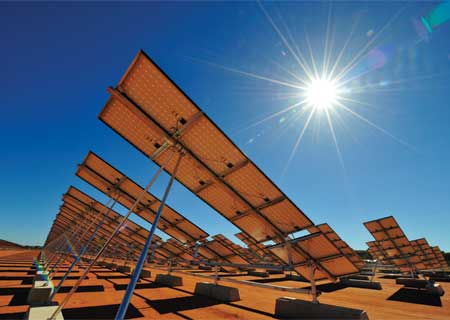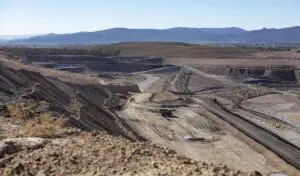
The Northern Territory’s conservative government and its state-owned power generator appear to have a thing against solar. So much so, they have gone to extraordinary lengths to demonise the technology, claiming it will cost up to $2 billion to power the city of Alice Springs with nothing but solar power.
No one is actually suggesting that Alice Springs should be powered 100 per cent by solar power just yet, although many are suggesting that added solar should not be ruled out. But the government is clearly feeling defensive about its recent decision to invest $75 million on a new gas generator, without any consideration for solar alternatives.
And its response to that criticism is revealing some heavily in-built prejudices and misunderstandings about solar power. And this in a city which likely already has the highest penetration of solar power in the country, has better sunshine than any capital city, and is described as the “solar heart of the country.”
We first wrote about the territory government’s antipathy to solar in April, in this story, Alice Springs: Solar city at centre of a fossil fuel controversy, when it was revealed that the government had responded to a major black-out by announcing a $75 million in new gas-fired generation, with apparently no consideration for any more renewables.
State treasurer Dave Tollner sought to justify the decision with a series of myths, falsehoods and complete misunderstandings about renewable energy, including the claim that when the sun shines, “or the wind starts to blow, and suddenly the cables are overloaded, they heat up, melt, collide and fail.”
Chief minister Adam Giles doubled up on those comments a few weeks ago, claiming that any efforts to go “100 per cent” solar would cost $1.4 billion, and suggesting that there was already too much solar in the system.
“There is a general rule that says, once you get to 20 per cent you start to have load issues, which is why you see blackouts in Alice Springs,” Giles said.
That’s not true, on several fronts. The big blackout in February was caused by a problem at the gas generator. And as a trial project involving Territory Generation and sponsored by the Australian Renewables Energy Agency pointed out in 2014, the city could easily obtain 60 per cent of its electricity supply from solar into the grid.
A report on that project said the increased variation in supply would be no different from the “noise” of varying levels of demand. It said such claims about variable supply sources were based on the assumption that all demand is constant. It almost never is. And grids like South Australia already get close to 50 per cent supply from wind and solar without issues, while smaller mini-grids go to 70 per cent or more.
But the government’s extraordinary estimates for the cost of going “100 per cent” solar are easily the most egregious.
We had asked Giles’ office, soon after his comments, where he got the $1.4 billion estimate from. We were told then that the government-owned Territory Generation was “putting together” some modelling and we would have to wait a week.
We actually had to wait a little longer than that, but part of it was finally released last week, by the general manager of Territory Generation, Tom Duignan. And in this part of the report, the cost of going 100 per cent solar had suddenly jumped, to between $1.5 billion and $2 billion, an investment that would lift electricity prices by 350 per cent.
 Even if someone was to suggest that Alice did go 100 per cent solar, which no one is, the numbers seem extraordinary. According to Duignan, enough solar and enough storage would need to be built to provide electricity for seven days with no sun. He pointed to a cloudy period from May 2 to May 8 when solar output had fallen 46 per cent.
Even if someone was to suggest that Alice did go 100 per cent solar, which no one is, the numbers seem extraordinary. According to Duignan, enough solar and enough storage would need to be built to provide electricity for seven days with no sun. He pointed to a cloudy period from May 2 to May 8 when solar output had fallen 46 per cent.
This, said several experts in solar and storage, was perfectly ridiculous, a clear sign of the “old way of thinking” against the new; the sort of mentality that thinks only in terms of “base load” power, and which has underpinned the gold-plating in Australia’s grid in recent years.

It is even more bizarre because Territory Generation calculated these scenarios (see above) on the basis that there would be 36MW of back-up dual-fuel power at the Owens plant in the system anyway. Why? Because it is needed just in case the gas generator fails, like it did in January.
So, any expert in solar and storage would ask, why on Earth would you be seeking to invest in seven days of storage when there are back-up generators? It makes absolutely no sense. We asked Territory Generation for a response on several occasions in the last few days. We have not received one.
One of the big differences between fossil fuels and renewables is that wind and solar cost more to build, but then run on a fuel cost of zero. The opposite is true of gas.
What, we asked Territory Generation, was for the cost of gas-fired power over the 25-years life of a solar farm? Would Territory Generation provide its estimates of the running costs of the gas plant – including the fuel cost – over the next 25 years? What is the cost of generating a single megawatt-hour at the gas plant?
Commercial in confidence, we were told. So we did a back-of-the-envelope calculation. The town’s average demand is said to be 25MW. Let’s say it costs $100/MWh, which is pretty generous, that would equate to around $22 million a year in fuel costs, or a minimum $550 million in fuel costs alone over the next 25 years.
That actually puts it in the ball-park of the concentrated solar power option that they considered, of about $600 million. A solar tower with molten storage meeting the town’s average 25MW power demand, and peaks of around 50MW, would probably be cheaper than that.
It would not, for instance, need 48-hour storage – not in a town that has 300 sunny days a year, as the township boasts, and certainly not with the 36MW of back-up plant.
As for the solar PV estimates. They seem perfectly ridiculous. 100MW of solar PV – which is what Territory Generation estimates would be needed – should cost no more than $300 million, even allowing for the remote area. If the plant was distributed into smaller areas, the cloud cover would be an issue.
Yes, battery storage would be needed, to help smooth out the output as clouds pass, and to provide “ancillary” services such as frequency. But it would be nowhere near the amount indicated by Territory Generation, and costs are expected to fall by half in coming years – about the time that any new capacity would be needed.
That is the point the Repowering Alice Springs community group has been arguing – for the people who run the grid to have some consideration for the future and include solar in the calculations, and not to rule it out on some ridiculous cost estimates of “solar only” using outdated ideas and practices.










